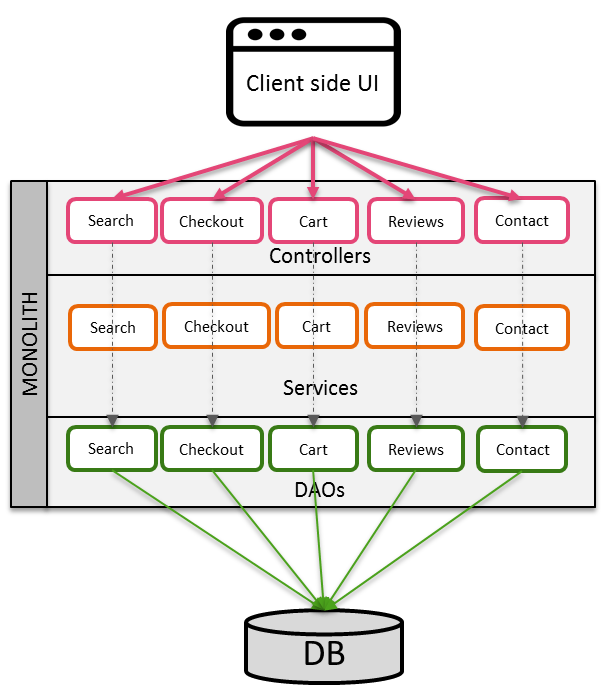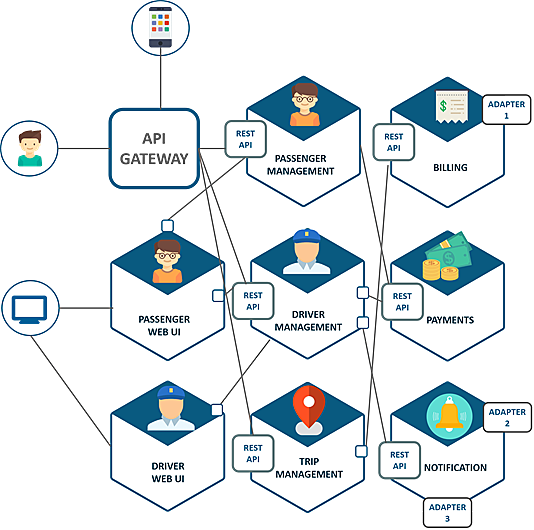 The traditional approach in software development is to create an application as a single structure consisting of multiple interconnected routines that form the application’s components. The applications attempted a unified model of the entire business. The number of domains under the application sprawl was directly proportional to the complexity. This style of application (building) is known as Monolithic in modern parlance. Enterprises conceived and built or implemented (COTS) complex monolith applications. This approach had its advantages in those days, particularly bringing the various business data domains under one colossal umbrella for keeping data consistent and well-governed. When on-premises compute powerhouses were the order of the day in the big businesses’ data centers, the application domains shared the compute power and the storage, thus making optimal use of the resources.
The traditional approach in software development is to create an application as a single structure consisting of multiple interconnected routines that form the application’s components. The applications attempted a unified model of the entire business. The number of domains under the application sprawl was directly proportional to the complexity. This style of application (building) is known as Monolithic in modern parlance. Enterprises conceived and built or implemented (COTS) complex monolith applications. This approach had its advantages in those days, particularly bringing the various business data domains under one colossal umbrella for keeping data consistent and well-governed. When on-premises compute powerhouses were the order of the day in the big businesses’ data centers, the application domains shared the compute power and the storage, thus making optimal use of the resources.
“As industry experts in cloud computing, we specialize in building serverless and containerized applications using a microservices architecture. Our team of experts reviews and examines the needs before deciding whether Microservices is a good fit for customers’ use cases.”
Fast-forward to the present age. The same old huge enterprise monoliths still have to talk to external systems with ever-growing distinct domains that keep popping up with innovative ways of doing business. The good old rules of the unified model of the entire business get constantly challenged and redefined and pretty much given up. Systems with disparate canonical data models are continually being brought together and made to talk to each other.
Thus the unified model is increasingly being replaced with an approach of the bounded context where the domain within the bounded context can have its own canonical model. One bounded context may have a few objects related to similar objects in another bounded context, but a vast majority of the objects are different in different bounded contexts.
As legacy applications face obsolescence both from a hardware and software perspective, enterprises are rethinking their replacement through modernization. One critical aspect of this modernization is migrating the Monolith applications to modern architecture. Complex interdependency between bounded contexts of sub-applications is eliminated through Microservices. Yet, this architecture can provide the same consolidated application views of the legacy applications’ data, thanks to the microservices architecture patterns.
This modern concept works by wrapping the logic of the bounded context application as a service, thereby enabling autonomy and removing a direct dependency. The various applications within their bounded context may not share storage across each other. They may not also share the computing resources of each other. Each service in the application can be combined or separated as required without hindering the efficiency of the overall application.
“We have implemented microservices in several new applications and also as an additional upgrade to existing applications. There have also been instances where we have advised our clients against microservices to avoid unnecessary complexities.”
Some of the critical advantages of microservices are:
- Requires Low maintenance and testing effort
- Loosely coupled architecture
- Independently deployable services
- A small team of developers can own it.
- Upgrade /scalability options are abundant.

Among the various types of microservices, the two popular styles are containerized and serverless. Each type has its advantages and drawbacks. Containerized microservices are used by frameworks such as springboot to create a self-sufficient standalone service that can be deployed in any compatible environment. A serverless option is more prevalent within the cloud environment. In this type, a function or a subroutine is deployed as a service invoked synchronously and/or asynchronously. This type also facilitates better collaboration among teams of diverse expertise by allowing developers to create services using any supported scripting language of their choice. The design of microservices should take care to avoid anti-patterns and fit the bounded contexts of the services within their domain model. Application of tactical Domain-Driven Design (DDD) patterns is also an essential task when designing microservices to define entities, aggregates, and domain services.
While there may be many advantages to implementing microservices, it is not for everyone. There are some drawbacks to the microservice architecture. The most commonly encountered disadvantages are:
- A separate inter-service communication mechanism is required to communicate between the services. This creates additional logic/layers in the application.
- Handling failures is more complex due to the lack of common failure fallback mechanisms.
- Implementing requests that span multiple services end up being convoluted.
- In the containerized type, all services are expected to run all the time, making it less different from monolithic services.
- In the serverless type, not accessed services often face cold start issues, which create undesirable latency during the first request to those services.
- Microservices are stateless and do not have shared storage by default. However, we can overcome this in the cloud by connecting to a storage service and passing the state information with each request.
Our engineers have the unique experience of migrating large scale high-loaded enterprise solutions running 24/7 with zero disruption, using a “parallel” approach. In this approach, the new application is built side-by-side with the legacy system. The legacy features are replaced one by one, based on a DDD (Domain-Driven Design) into the to-be state microservices architecture application components. Data synchronization approaches ensure users can work with both systems during the migration period. Should something go wrong, there is always an ability to roll back. Once all modules and features are migrated, the old system is slowly retired.
Talk to us today
to see how we can help you in your legacy modernization effort.
